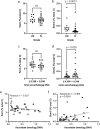Ascorbate content of clinical glioma tissues is related to tumour grade and to global levels of 5-hydroxymethyl cytosine
- PMID: 36050369
- PMCID: PMC9436949
- DOI: 10.1038/s41598-022-19032-8
Ascorbate content of clinical glioma tissues is related to tumour grade and to global levels of 5-hydroxymethyl cytosine
Abstract
Gliomas are incurable brain cancers with poor prognosis, with epigenetic dysregulation being a distinctive feature. 5-hydroxymethylcytosine (5-hmC), an intermediate generated in the demethylation of 5-methylcytosine, is present at reduced levels in glioma tissue compared with normal brain, and that higher levels of 5-hmC are associated with improved patient survival. DNA demethylation is enzymatically driven by the ten-eleven translocation (TET) dioxygenases that require ascorbate as an essential cofactor. There is limited data on ascorbate in gliomas and the relationship between ascorbate and 5-hmC in gliomas has never been reported. Clinical glioma samples (11 low-grade, 26 high-grade) were analysed for ascorbate, global DNA methylation and hydroxymethylation, and methylation status of the O-6-methylguanine-DNA methyltransferase (MGMT) promoter. Low-grade gliomas contained significantly higher levels of ascorbate than high-grade gliomas (p = 0.026). Levels of 5-hmC were significantly higher in low-grade than high-grade glioma (p = 0.0013). There was a strong association between higher ascorbate and higher 5-hmC (p = 0.004). Gliomas with unmethylated and methylated MGMT promoters had similar ascorbate levels (p = 0.96). One mechanism by which epigenetic modifications could occur is through ascorbate-mediated optimisation of TET activity in gliomas. These findings open the door to clinical intervention trials in patients with glioma to provide both mechanistic information and potential avenues for adjuvant ascorbate therapy.
© 2022. The Author(s).
Conflict of interest statement
The authors declare no competing interests.
Figures




References
Publication types
MeSH terms
Substances
LinkOut - more resources
Full Text Sources
Medical
Research Materials

